
Bigfoot is the name given to a large bipedal ape like creature reported to roam the remote forest areas of the United States, specifically the Pacific North West, California, the Rocky Mountains, the Great Lakes region, and some of the Northeast and Southern states. Bigfoot is most likely very closely related if not the same species as Canada’s Sasquatch, similar reports of a creature like Bigfoot have been reported all over the world, including, Malaysia, China, Russia, Australia and South America to name a few.
Individuals who claim to have seen Bigfoot often give very similar descriptions, a 7 to 9 foot tall, ape or human like bipedal creature with broad shoulders, no visible neck, and pointed head similar to the crest of a male gorilla. Reports also sometimes note large eyes, a pronounced brow, and a large, low set forehead. A pungent odor, similar to feces, sewage or strong body odor, is also associated with most Bigfoot sightings.  As the name would suggest the creature also appears to have some very large feet. According to the late Smithsonian Primatologist John Napier noted that “the term Bigfoot has been in use since the early 1920’s to describe large, unaccountable human like footprints in the Pacific Northwest,” According to the renowned Cryptozoologist Loren Coleman the term Bigfoot was first used in print by Humboldt Times Columnist Andrew Genzoli on October 5, 1958 after construction worker Jerry Crew entered the Humboldt newsroom with plaster casts he made of gigantic footprints he discovered embedded in the mud near Bluff Creek Valley.
As the name would suggest the creature also appears to have some very large feet. According to the late Smithsonian Primatologist John Napier noted that “the term Bigfoot has been in use since the early 1920’s to describe large, unaccountable human like footprints in the Pacific Northwest,” According to the renowned Cryptozoologist Loren Coleman the term Bigfoot was first used in print by Humboldt Times Columnist Andrew Genzoli on October 5, 1958 after construction worker Jerry Crew entered the Humboldt newsroom with plaster casts he made of gigantic footprints he discovered embedded in the mud near Bluff Creek Valley.
Ecologist Robert Pyle describes most Bigfoot tracks as commonly measuring fifteen to eighteen inches or more in length, having five toes, a double muscle ball, and a low arch. Some foot prints that come out of north Louisiana appear to only have 3 toes, some researchers into this phenomenon believe that the local Bigfoot population has been cut off from their major roots of travel and forced to inbreed. It is a known scientific fast that fingers and toes are one of the first things effected by inbreeding. 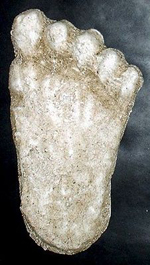 The earliest documented reports of a large ape like creature in the Pacific Northwest date back to 1924, after a series of alleged encounters at a gorge on the northeast shoulder of Mount St. Helens in Washington State. This gorge, which runs along the Plains of Abraham, narrows to as close as eight feet in some places and would later be named Ape Canyon due to the number of reports of ape like creatures in the area. Ape Canyon was reportedly the site of a violent encounter in 1924, between a group of minors and a group of Bigfoot. The minors account was published in several July 1924 issues of The Oregonian, a major daily newspaper in Portland Oregon. One of the Minors, Fred Beck, claimed that the minors shot and killed a large ape like creature and that night a group of Bigfoot attacked their cabin and tried to break in.
The earliest documented reports of a large ape like creature in the Pacific Northwest date back to 1924, after a series of alleged encounters at a gorge on the northeast shoulder of Mount St. Helens in Washington State. This gorge, which runs along the Plains of Abraham, narrows to as close as eight feet in some places and would later be named Ape Canyon due to the number of reports of ape like creatures in the area. Ape Canyon was reportedly the site of a violent encounter in 1924, between a group of minors and a group of Bigfoot. The minors account was published in several July 1924 issues of The Oregonian, a major daily newspaper in Portland Oregon. One of the Minors, Fred Beck, claimed that the minors shot and killed a large ape like creature and that night a group of Bigfoot attacked their cabin and tried to break in.
The director of the Western Speleological Survey, William Halliday, claimed in his 1983 pamphlet “Ape Cave and the Mount Saint Helens’ Apes” that the minor’s assailants where actually local youth. Until the very last summer of Ape Canyon existence in 1979, the canyon was almost completely destroyed by the 1980 eruption of Mount St. Helens, counselors from the YMCA’s Camp Meehan on nearby Spirit Lake brought hikers to the canyons edge and retold a tradition that the 1924 incident was actually the result of young campers throwing light pumas stones into the canyon, not realizing there where minors at the bottom. Looking up the minors would have only seen dark moonlit figures throwing stones at their camp, the narrow walls of the canyon would have served to distort the voices of the YMCA campers enough to frighten the men below.
However, Halliday's explanation may fail to account for several factors:
• Beck claimed that the "apes" were seen clearly enough to note that they were not human;
• Beck claimed that one of the "apes" was shot and killed, but its unclear if Halliday claims that one of the stone-throwing teenagers was shot and killed in 1924.
• According to a series of 1924 articles in The Oregonian, multiple reporters and other eyewitnesses saw damage to the cabin, and enormous footprints at the scene, and it's difficult to imagine how stone throwing teenagers might have caused these details.
Another strange occurrence associated with the Ape Canyon area happened in 1950. A skier by the name of Jim Carter was with a group of men but went off by himself to film a documentary and was never seen again. During a massive search of the area to locate Jim one of the search team members said he had a chilling feeling of being watched the entire time. Carter’s ski tracks seemed to indicate that he took off at a very high speed, making tremendous jumps that not even an experienced skier would attempt to make unless frightened beyond reason or being chased. 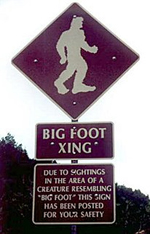 The majority of Bigfoot reports come from areas with very low human populations, however many do originate from parks located near major cities, cities like Portland, Oregon, Washington, DC, and Baltimore, Maryland to name a few. In addition most sightings occur near rivers, creeks, or lakes, and from areas where annual rain fall exceeds twenty inches. Researchers point out that these common factors indicate patterns of living species occupying an ecological niche, as opposed to hoaxed sightings.
The majority of Bigfoot reports come from areas with very low human populations, however many do originate from parks located near major cities, cities like Portland, Oregon, Washington, DC, and Baltimore, Maryland to name a few. In addition most sightings occur near rivers, creeks, or lakes, and from areas where annual rain fall exceeds twenty inches. Researchers point out that these common factors indicate patterns of living species occupying an ecological niche, as opposed to hoaxed sightings.
Critics suggest people may have mistaken bears for Bigfoot, as sightings are some times near the known habitats of bears. However, witnesses include experienced hunters and outdoorsmen who claim to be familiar with bears and insist that the creatures they saw were not bears. Biologist John Bindernagel argues that there are marked differences between bears and Bigfoot sightings that make confusion unlikely. He noted that the profile of a bears snout is far different than that of a Bigfoot’s flat face. In frontal view, Bigfoot’s square broad shoulders contrast with that of a bears more tapered shoulders. Bigfoot also has relatively long legs that allow for a fluid and graceful stride, which is in large contract to the short legged shuffles of a bear when it walks on its hind legs. A bears ears are also naturally visible, while those of the Bigfoot are often hidden under long hair.
It has been suggested that a large number of people reporting Bigfoot sightings could be the victims of a hoax or possibly confused about what they actually encountered.. John Napier wrote that however accurate and sincere witness might seem, "eyewitness reports must be treated with considerable caution. Although we don't always know what we see, we tend to see what we know". He also adds, "without checking possible ulterior motivations, eyewitnesses cannot be acceptable as primary data".  Eyewitness reports will never be enough to make main stream science recognize the existence of Bigfoot, which is why Bigfoot researchers have made numerous claims that there is physical evidence to support the existence of Bigfoot. However the physical evidence which has been presented is seen minimal interest from the so called mainstream experts and is regarded as far from conclusive. This physical evidence takes many forms including footprints, handprints, fingerprints, the Skookum body cast, hair samples and blood samples.
Eyewitness reports will never be enough to make main stream science recognize the existence of Bigfoot, which is why Bigfoot researchers have made numerous claims that there is physical evidence to support the existence of Bigfoot. However the physical evidence which has been presented is seen minimal interest from the so called mainstream experts and is regarded as far from conclusive. This physical evidence takes many forms including footprints, handprints, fingerprints, the Skookum body cast, hair samples and blood samples.
Although rare, Bigfoot’s footprints seem to be the most common form of physical evidence that would suggest a large bipedal creature exists. Cryptozoologists often use plaster casts and photographs to document presumed Bigfoot footprints. Anthropologist Grover Krantz writes, “the push off mound in mid footprint is one of the most impressive pieces of evidence to me.” The mound he refers to is a small grouping of soil created by a horizontal push of the forefoot just before it leaves the ground, which is present in some Bigfoot tracks. Krantz argues that neither artificial wood nor rubber Bigfoot feet could create this convincing feature, as he himself discovered after many attempts. Krantz also notes that reported Bigfoot steps are in excess of three feet, arguing that the enormous step would be difficult and almost impossible for any hoaxer to create.
Respected Bigfoot Researcher Loren Coleman and Jerome Clark, a well respected UFO researcher, write that there are some Bigfoot footprints that are hoaxes, but argue that they are often clumsy in comparison to presumably genuine footprints, which show distinctive forensic features that to an investigator would indicate that they are not fakes. Krantz also noted that toe positions can and do vary from one imprint to another on the same foot. It is Krantz’s opinion that Bigfoot toes are more mobile than those on civilized human feet and that hoaxing this detail would require detailed knowledge of anatomy as well as dozens if not hundreds of different casts for each set of Bigfoot tracks, making a hoax very unlikely in these cases. 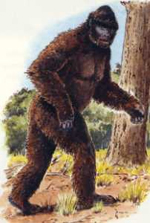 Researcher Henry Franzoni writes:
Researcher Henry Franzoni writes:
“A strong piece of evidence which suggests that the footprints are not due to a hoax or hoaxers is from Dr. Henner Farenbach. He has studied a database of 550 track cast length measurements and has made some interesting observations. The Gaussian distribution of the 550 footprint lengths gives a curve that is very similar to the curve given by living populations of known animals with out much sexual dimorphism in footprint lengths. The standard error is very low, so additions to the database will not affect the result very much. It is not very likely that coordinated groups of hoaxers conspiring together for 38 years, the time span covered by the database of track measurements, could provide such a life like distribution in footprint lengths. Groups of hoaxers who did not conspire together would almost certainly result in a non Gaussian distribution for the database of footprint lengths.”
In 1969 a series of alleged Bigfoot tracks where found near Bossburg, Washington, these footprints appeared to show that the creature’s right foot was affected by Clubfoot, a birth defect which, if left untreated, will make the person affected appear to walk on their ankles, or on the sides of their feet. These deformed footprints are consistent with genuine disfigurement, and some argue that a hoax is unlikely. John Napier wrote, "It is very difficult to conceive of a hoaxer so subtle, so knowledgeable; and so sick; who would deliberately fake a footprint of this nature. I suppose it is possible, but it is so unlikely that I am prepared to discount it." Krantz declared that "analysis of the apparent anatomy of these tracks proved to be the first convincing evidence that the animals were real.”
Another argument offered for the existence of Bigfoot are handprints, Krantz cited two alleged Bigfoot handprints from northern Washington State in the summer of 1970. He claims that the left handed prints showed a very broad, flat palm, more than twice as broad as his own, larger than average hands, with stubby fingers, lacking an opposable thumb. Krantz went on to write that the prints have many irregularities which cannot be identified in terms of human anatomy. Krantz obtained another pair of alleged hand prints from Paul Freeman, an American Bigfoot hunter in the late 1980’s, he judged these prints as genuine as well for similar reasons as the first.
Several alleged hand and footprint impressions containing dermal ridges, fingerprints, have been discovered, this is significant because fingerprints are only present on humans and other primates, suggesting that they are not a hoax. Krantz reports that he offered casts of these prints to more than forty individual law enforcement fingerprint specialists across Canada and the United States for study. The reactions that he received ranged from "'very interesting' and ‘they sure look real' to 'there is no doubt these are real.' The only exception was the Federal Bureau of Investigation expert who reportedly said something to the effect of 'The implications of this are just too much; I can't believe it's real'".
One of the casts with visible fingerprints showed what Krantz took to be sweat pores. Krantz reports that police expert Benny Kling commented that anyone who could engrave ridge detail of such quantity and quality should be making counterfeit money..This same print showed dysphasia, a common minor irregularity. Krantz writes, "The late Robert Olson was particularly impressed with this irregularity, as was Ed Palma of the San Diego Police Department". 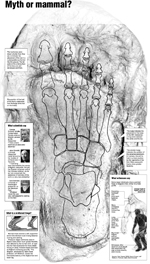 Perhaps the most interested cast evidence of Bigfoot is the Skookum Body Cast. The Skookum Cast is a plaster cast taken on September 22, 2000 during a Bigfoot Field Researchers Organization expedition to the Skookum Meadows area of the Gifford Pinchot National Forest in Washington state. The cast, which measures 3 ½ by 5 feet and weighs approximately 400 lbs, is said to be of a partial body imprint in the mud. Some researchers believe the imprint was made by a living Bigfoot, which was evidently sitting on the ground to reach for fruit set out as bait by the researchers the previous night. Indeed, the body dimensions of the cast are reportedly 40 to 50 percent larger than that of a six-foot tall human and shows the imprint of a huge forearm, hip, thigh, heel ankle, and Achilles tendon. Impressions of hair are evident on the buttocks and thigh surfaces of the cast, as well as much longer fringes of hair on the forearm region. Dermal ridges appear on the heel, with many of the same characteristics consistently found on other purported Bigfoot samples.
Perhaps the most interested cast evidence of Bigfoot is the Skookum Body Cast. The Skookum Cast is a plaster cast taken on September 22, 2000 during a Bigfoot Field Researchers Organization expedition to the Skookum Meadows area of the Gifford Pinchot National Forest in Washington state. The cast, which measures 3 ½ by 5 feet and weighs approximately 400 lbs, is said to be of a partial body imprint in the mud. Some researchers believe the imprint was made by a living Bigfoot, which was evidently sitting on the ground to reach for fruit set out as bait by the researchers the previous night. Indeed, the body dimensions of the cast are reportedly 40 to 50 percent larger than that of a six-foot tall human and shows the imprint of a huge forearm, hip, thigh, heel ankle, and Achilles tendon. Impressions of hair are evident on the buttocks and thigh surfaces of the cast, as well as much longer fringes of hair on the forearm region. Dermal ridges appear on the heel, with many of the same characteristics consistently found on other purported Bigfoot samples.
Henner Fahrenbach, a biomedical scientist from Beaverton, Oregon, analyzed hair samples from the cast and identified a single distinctly primate hair, which he believes belongs to a Bigfoot. The heel, ankle and Achilles tendon impressions in the cast were studied by Jeff Meldrum of Idaho State University, and the anatomy is comparable to models of a Bigfoot foot Meldrum created after examining hundreds of alleged Sasquatch footprints. The cast has also been investigated by many leading Bigfoot researchers, including John Green, Grover Krantz, John Bindernagel, and Meldrum, who believe the cast to be authentic, and solid evidence of the existence of Bigfoot.
Plaster casts are not all that we have to show for our selves after years of collecting Bigfoot evidence, we have also managed to find several possible blood and hair samples over the years. In 1968 hairs retrieved from a bush in Riggins, Idaho were given to Roy Pinker, a police science instructor at California State University in Los Angeles. After studying the hairs Pinker was able to conclude that the hair samples did not match any samples from known animal species. Pinker also noted that he could not attribute them as being Bigfoot hairs with out an actual Bigfoot hair sample to compare it to. It is important to note that the analysis by Pinkered did not use DNA testing as it was not in use at the time. 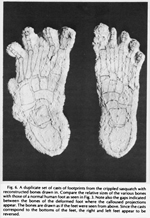 Hair samples were also taken from a house located on the Lummi Indian reservation in Washington along with three more samples retrieved from Maryland, Oregon and California. Forensic Anthropologist Dr. Ellis R. Kerley and Physical Anthropologist Dr. Stephen Rosen of the University of Maryland, as well as Tom Moore, the Supervisor of the Wyoming Game and Fish Laboratory, examined the hair samples and stated that all the hair samples matched in terms of belonging to a "non species specific mammal". They concurred in finding that the four sets matched each other, were similar to gorilla and human but were neither, and they did not match 84 other species of North American mammals. Blood associated with the sample from Idaho was tested by Dr. Vincent Sarich of the University of California and found to be that of an unknown higher primate. These too were not subjected to DNA testing, which was not available at the time.
Hair samples were also taken from a house located on the Lummi Indian reservation in Washington along with three more samples retrieved from Maryland, Oregon and California. Forensic Anthropologist Dr. Ellis R. Kerley and Physical Anthropologist Dr. Stephen Rosen of the University of Maryland, as well as Tom Moore, the Supervisor of the Wyoming Game and Fish Laboratory, examined the hair samples and stated that all the hair samples matched in terms of belonging to a "non species specific mammal". They concurred in finding that the four sets matched each other, were similar to gorilla and human but were neither, and they did not match 84 other species of North American mammals. Blood associated with the sample from Idaho was tested by Dr. Vincent Sarich of the University of California and found to be that of an unknown higher primate. These too were not subjected to DNA testing, which was not available at the time.
Several audio recordings that may suggest that Bigfoot is real have been brought to light, analysis of suspected Bigfoot vocalizations were analyzed by leading bioacoustics expert Dr. Robert Benson of Texas A&M University, Corpus Christi, he reported that some recordings "left him puzzled", and helped change his opinion from being a raving skeptic to being curiously receptive of Bigfoot.
Video footage of large bipedal hominid have also been collected as evidence, none more well known and more fiercely debated than the Patterson-Gimlin film. This 53 second long motion picture was shot on October 20th 1967 by Roger Patterson and Robert Gimlin who claimed the video to be a genuine recording of a Bigfoot. Some researchers declared the video a hoax almost immediately, stating that it showed nothing more than a man in an ape suit. But others, such as physical anthropologist Grover Krantz, are convinced that the film showed an actual undiscovered creature. Others, such as ecologist Robert Michael Pyle, refuse to state that the film is the real thing but admit that the video as never been adequately debunked.  Skeptics find it significant that the fossil record does not support the existence of Bigfoot and are quick to point out that other large North American animals like the cougar, moose, and mammoth are well represented. Yet, aside from clearly human remains, there is no evidence to suggest a prehistoric hominid or any other ape ever existed in North America. In addition no specimen of fossilized coprolites, dung, has ever been discovered, as is common with other ancient North American species.
Skeptics find it significant that the fossil record does not support the existence of Bigfoot and are quick to point out that other large North American animals like the cougar, moose, and mammoth are well represented. Yet, aside from clearly human remains, there is no evidence to suggest a prehistoric hominid or any other ape ever existed in North America. In addition no specimen of fossilized coprolites, dung, has ever been discovered, as is common with other ancient North American species.
Bigfoot researchers maintain that although there is an absence of fossil evidence dose not mean that there are no fossils of these creatures, just that they have not yet been discovered. Loren Coleman and Patrick Huyghe note that no one will look for such fossils if the creature involved is not thought to exist in the first place, and even with recognized primates fossil finds are normally meager at best. It is worth noting here that the majority of recognized primate species live in tropical rain forests where conditions are not ideal for creating fossils, in contrast there are thousands of known Native American mammal and human remains. Fossilization also requires ideal conditions, such as being covered by a landslide or mudslide shortly after death so that mineralization can take place on an undisturbed carcass.
Krantz suggests that the lack of Bigfoot remains alone is not a valid argument against the existence of the creature. He notes that most animals hide before dying and are then quickly lost to a number of different scavengers, he writes “I have yet to meet anyone who has found the remains of a bear that was not killed by human activity.” It has also been suggested that if any Bigfoot remains were ever found, they may have been mistaken for larger than normal human remains. Unusually large American Indian remains, greater than 6 and a half feet tall, were often discovered in Ohio, Utah and Tennessee through out the 1800’s. One such discover was documented by author John Haywood in his book, The Natural and Aboriginal History of Tennessee. In this book Haywood describes skeletons found in White County, Tennessee, in 1821 which averaged an estimated 7 feet in length. These findings left some researchers to wonder if perhaps the remains of a Bigfoot or many Bigfoot have in fact been discovered only to be mistaken for the remains of a taller than average human, if this was the case perhaps Bigfoot is far more human like than we originally thought. 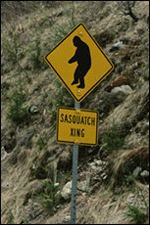 The biggest problem with proving the existence of Bigfoot is not the lack of solid evidence but rather the abundance of hoaxed evidence. Perhaps the biggest claim of a hoax, besides that of the Patterson-Gimlin film was made in 2002 by the family of Raymond L. Wallace. After Mr. Wallace passed away, his family published what they claimed to be the details of many of Mr. Wallace Bigfoot hoaxes dating back to 1958. They even claimed that the footprint found by Jerry Crew at an isolated construction site in Humboldt County California, the very one that gave rise to the term Bigfoot, was the work of Mr. Wallace.
The biggest problem with proving the existence of Bigfoot is not the lack of solid evidence but rather the abundance of hoaxed evidence. Perhaps the biggest claim of a hoax, besides that of the Patterson-Gimlin film was made in 2002 by the family of Raymond L. Wallace. After Mr. Wallace passed away, his family published what they claimed to be the details of many of Mr. Wallace Bigfoot hoaxes dating back to 1958. They even claimed that the footprint found by Jerry Crew at an isolated construction site in Humboldt County California, the very one that gave rise to the term Bigfoot, was the work of Mr. Wallace.
Giving some credibility to these claims was the fact that Raymond Wallace’s brother, Wilbur L. Wallace was the over seer of the construction site Mr. Crew found the print at. However these claims and Mr. Wallace himself are poorly regarded by many who take the subject of Bigfoot seriously. Bigfoot supporters deny the family’s claims and one writer even pointed out that the wooden track stompers shown to the media by the Wallace family do not match photos of the 1958 tracks they claim their father made, he continues by pointing out that the feet are a different shape all together.
Primatologist John Napier acknowledged that there have been some hoaxes but also stated that hoaxing is often an inadequate explanation for all of the Bigfoot sightings and tracks. Krantz later added that it would require something like 100,000 casual hoaxers to explain the many Bigfoot footprints.
The idea of Bigfoot is so clouded with dubious claims and hoaxes that many scientists do not give the subject the time of day. Napier wrote that the mainstream scientific community’s indifference stems primarily from insufficient evidence. He also notes that scientists prefer to investigate the probable rather than beat their heads against the wall of the faintly possible. Krantz later stated that the scientific establishment generally resists new ideas, and there is good reason for it. Simply put, new and innovative ideas in science are almost always wrong.
Although most scientists find the current evidence in the case of Bigfoot unpersuasive, a number of respected experts have spoken out on the topic of Bigfoot. In an interview on National Public Radio in 2002, Jane Goodall publicly expressed her belief in Bigfoot, saying, “Well, I'm a romantic, so I always wanted them to exist. Of course the big criticism of all this is, where is the body? You know, why isn't there a body? I can't answer that, and maybe they don't exist, but I want them to.”
In 2004, Henry Gee, editor of the prestigious Nature, argued that creatures like Bigfoot deserved further study, writing, "The discovery that Homo floresiensis survived until so very recently, in geological terms, makes it more likely that stories of other mythical, human-like creatures such as Yetis are founded on grains of truth . Now, cryptozoology, the study of such fabulous creatures, can come in from the cold."
In an essay entitled, Sasquatch Must Exist, published after his death, prominent anthropologist Carleton S. Coon wrote "Even before I read John Green's book, Sasquatch: The Apes Among Us, first published in 1973, I accepted Sasquatch's existence.” Coon examines the question from several angles, stating that he is confident only in ruling out a relict Neanderthal population as a viable candidate for Sasquatch reports. Coon may have ruled out Neanderthal man as the identify of Bigfoot but many researchers point out other creatures which may possibly be behind Bigfoot sightings. 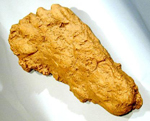 A large number of researchers, including Grover Krantz, feel that the most likely candidate to explain Bigfoot is a relict population of Gigantopithecus blacki, a very large ape known only by a few jaw bones and teeth fragments found in Southeast Asia. Fossils of Gigantopithecus have also been found in extreme eastern Siberia, which has forests similar to Northwestern North America. Believers in this theory suggest that like so many other recognized species, Gigantopithecus may have migrated across the Bering Strait, settling down in the forests of North America. This theory however is considered highly speculative, mainstream science views Gigantopithecus as a quadruped, and study of the Patterson-Gimlin film show a slender lower mandible, which does not match the massive lower jaw of Gigantopithecus. Assuming the Patterson-Gimlin footage is legitimate, Bigfoot and Gigantopithecus could not be one in the same.
A large number of researchers, including Grover Krantz, feel that the most likely candidate to explain Bigfoot is a relict population of Gigantopithecus blacki, a very large ape known only by a few jaw bones and teeth fragments found in Southeast Asia. Fossils of Gigantopithecus have also been found in extreme eastern Siberia, which has forests similar to Northwestern North America. Believers in this theory suggest that like so many other recognized species, Gigantopithecus may have migrated across the Bering Strait, settling down in the forests of North America. This theory however is considered highly speculative, mainstream science views Gigantopithecus as a quadruped, and study of the Patterson-Gimlin film show a slender lower mandible, which does not match the massive lower jaw of Gigantopithecus. Assuming the Patterson-Gimlin footage is legitimate, Bigfoot and Gigantopithecus could not be one in the same.
John Napier and anthropologist Gordon Strasenburg believe that should a creature like Bigfoot exist the most likely candidate would be a species of Paranthropus, an extinct human genus which is thought to have inhabited forested areas of Africa some 2 million years ago. One member of this genus, scientific name Paranthropus robustus, would have looked very similar to Bigfoot, including the crested skull and naturally bipedal gait.
The American Indians believed that Bigfoot, although being a very real being, exists on a separate plane of existence than humans. According to the Indian’s legend, Bigfoot is a spiritual being with the ability to cross between these planes of existence at will. Modern believers in the Indian legends will often site this ability to cross between planes as a means to explain why a Bigfoot corpse has never been found, also these believers feel that this would also explain why a breading population of Bigfoot has never been discovered.
There is also a little known subspecies of Homo erectus known as Meganthropus, which reportedly grew to enormous proportions. Some of the more extreme claims state that this giant could grow to heights greater than 9 feet tall and weighted up to 1000 pounds. Though a small handful of researchers believe that Meganthropus could be the true identity of Bigfoot, it is important to note that no official dimensions of this creature have been established and some evidence does suggest that it was no bigger than the average Homo erectus, also all known fossil evidence of Meganthropus was discovered thousands of miles away from North America on the Indonesian islands. 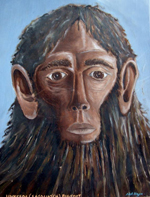 Although it is unclear what Bigfoot really is or if the creature even exists at all, enough evidence has been collected to warrant many formal studies of the creature. In 1955 Bernard Heuvelmans, who many consider to be the father of modern cryptozoology, discussed the existence of the Yeti in his book, On the Track of Unknown Animals. In the 1960’s Ivan T Sanderson wrote several articles on mysterious animals, including Bigfoot, some of which appeared in the Saturday Evening Post, a popular weekly magazine. Sanderson’s book, Abominable Snowmen: Legend Comes to Life, is considered the first book length study of “hairy hominids” and certainly helped popularize the Bigfoot legend.
Although it is unclear what Bigfoot really is or if the creature even exists at all, enough evidence has been collected to warrant many formal studies of the creature. In 1955 Bernard Heuvelmans, who many consider to be the father of modern cryptozoology, discussed the existence of the Yeti in his book, On the Track of Unknown Animals. In the 1960’s Ivan T Sanderson wrote several articles on mysterious animals, including Bigfoot, some of which appeared in the Saturday Evening Post, a popular weekly magazine. Sanderson’s book, Abominable Snowmen: Legend Comes to Life, is considered the first book length study of “hairy hominids” and certainly helped popularize the Bigfoot legend.
In the 1970’s John Napier published what is considered to be the first mainstream scientific study of available evidence in his book, Bigfoot: The Yeti and Sasquatch in Myth and Reality. In 1974 The National Wildlife Federation funded a field study geared towards seeking out Bigfoot and related evidence, no notable discoveries were obtained from this study. In 1975, the existence of Bigfoot was briefly discussed in the book, The Gentle Giants: The Gorilla Story, co authored by noted anthropologist Geoffery H. Bourne. In May of 1978 the University of British Columbia hosted a symposium entitled, Anthropology of the Unknown: Sasquatch and Similar Phenomena, a Conference on Humanoid Monsters. All who attended, mostly people with a background in anthropology, took the topic seriously, and while few accepted the existence of such creatures, they jointly concluded that there is no ground to dismiss all the evidence as a hoax or misinterpretation.
After the 1970’s boon in popularity there was only a hand full of formal academic scientific studies into Bigfoot.. In 1980 Marjorie Halpin and Michael Ames, using papers taken from the 1978 University of British Columbia symposium, published the book, Manlike Monsters on Trail: Early Records and Modern Evidence. In 2001 Reinhold Messner, an Italian Mountaineer, published the book, My Quest for the Yeti: Confronting the Himalayas’ Deepest Mystery, based on his1997 encounter with a Yeti. In his book Messner argues that the Yeti is actually an endangered Himalayan Brown Bear that has the ability to walk upright.
In addition to academic studies of Bigfoot several organizations have also been created which devote there time and resources to the study and exploration into the Bigfoot phenomena, the most well known of these organizations is the Bigfoot Field Researchers Organization. The BFRO was founded in 1995 and seeks to resolve the mystery surrounding the legend of Bigfoot, the main goal of the BFRO is to derive conclusive documentation of the species’ existence. According to the BFRO website this goal is pursued through the proactive collection of empirical data and physical evidence from the field and by means of activities designed to promote an awareness and understanding of the nature and origin of the evidence.
The BFRO, the oldest and largest organization of its kind, is directed by a virtual community of scientists, journalists, and specialists from diverse backgrounds. The researchers who compose the BFRO are constantly engaged in projects including field and laboratory investigations designed to address various aspects of the Bigfoot phenomenon. As a result of the education and experience of its members and the quality of their efforts, the BFRO is widely considered as the most credible and respected investigative network involved in the study of this subject.
In recent years, thanks to the efforts of these organizations and individuals like Loren Coleman, Bigfoot’s popularity has reached record levels. Main steam television stations have cashed in on the popularity of Bigfoot and produced a multitude of shows and movies on the creature. The Sci Fi Channel has produced several original movies on the creature and the National Geographic Channel featured Bigfoot as the topic of one of its hour long broadcasts of “Is It Real?’ The Discovery and History Channels have also featured Bigfoot in several of their shows geared towards the unknown. Resent advertising has also helped to push Bigfoot into mainstream pop culture, an example of this would be the “Messin With Sasquatch” commercials by Jack Links Beef Jerky, which show a couple of hikers who stumble upon a Bigfoot doing day to day things like sleeping or cooking and decide to play a prank on the creature such as putting shaving cream in his hand then tickling his nose, we all know that classic prank, or unscrewing the top of his salt shaker so that when he goes to use it the salt spills all over his food.
Bigfoot has also appeared in text at an increasing rate over the last few years, appearing in everything from supermarket tabloids to more serious writings. For example, The Weekly World News occasionally runs stories on the creature, and several novels have been written based on Bigfoot, such as the book Monster, which describes the kidnapping of a woman by a group of Bigfoot. Bigfoot has even appeared as a character in several Marvel Comics, this mutant, named Sasquatch, could transform from an ordinary looking human into a creature resembling the legendary Bigfoot. Toronto based, Graham Roumieu, wrote and illustrated two comical books about Bigfoot, The first titled, Me Write Book: It Bigfoot Memoir, and the second titled, In Me Own Words: The Autobiography of Bigfoot.
With new sightings of Bigfoot being reported everyday and more plaster casts of the creature’s foot than we know what to do with, at the end of the day we are still no closer to proving the existence of Bigfoot than we were the days past. Could the whole thing be, as some suggest, a mass case of War of the Worlds syndrome, people seeing things that aren’t really there just because they are told that something is there? And until a body or live creature is brought back to be examined by science the truth is we may never be able to fully explain the Bigfoot phenomena The burden of proof now rests on the shoulders of believers, science tells us Bigfoot does not exist, its up to us to tell science otherwise. And thus we leave you with the words of John Napier, “If one track and one report are true bill, then myth must be chucked out the window and reality admitted through the front door.”
The Evidence
Physical evidence to support the existence of Bigfoot comes in many forms, the following is a brief overview of the different types of evidence which has been presented to the scientific community.
Footprints – Though rare themselves, plaster casts and photos of alleged Bigfoot footprints are the most common form of physical evidence discovered to date. Often dismissed as hoaxes by main stream science, some of these casts display features which, according to many experts, could not have been faked. Features including push off mounds, varying toe positions and one case of club foot are considered to specific to be the work of a hoaxer using plastic or wooden feet.
Handprints – A few reports of Bigfoot handprints have been studied over the years. These so called hand prints are generally flat palmed and more than twice the size of a normal human’s hand.
Dermal Ridges – Also known as fingerprints these dermal ridges have been discovered on several foot and hand print molds. These casts have been studied by top police fingerprint experts and found to be to difficult to hoax, including some that appear to have been damaged, such as a cut or gash in the skin, and then healed over creating distinct patterns. If these where to be hoaxed it would take a person with intimate knowledge of biology and healing of the skin. Its important to note that prints with dermal ridges so important because dermal ridges themselves are only found on humans and primates.
Skookum Body Cast -.The Skookum Cast is a plaster cast taken on September 22, 2000 during a Bigfoot Field Researchers Organization expedition to the Skookum Meadows area of the Gifford Pinchot National Forest in Washington state. The cast, which measures 3 ½ by 5 feet and weighs approximately 400 lbs, is said to be of a partial body imprint in the mud. Some researchers believe the imprint was made by a living Bigfoot, which was evidently sitting on the ground to reach for fruit set out as bait by the researchers the previous night.
Hair Samples – Several hair samples believed to be from Bigfoot have been collected and studied over the years. Normally these hairs turn out to belong to common animals such as deer or bears, however on rare occasions a hair will prove to belong to an unknown primate species. With out an actual Bigfoot hair to compare these hairs to it is impossible to say for sure that that they come from the legendary creature, but that fact that someone has found an unknown primate hair in the United States is reason to consider the possibility.
The Sightings
There are so many sightings of Bigfoot that we could not possibly list them all here, however below you will find several of the more significant sightings through out the years.
1840: Protestant missionary Reverend Elkanah Walker records myths of hairy giants persistent among Native Americans living in Spokane, Washington. The Indians report that said giants steal salmon and have a strong smell.
1893: An account by Theodore Roosevelt is published this year in The Wilderness Hunter. Roosevelt relates a story which was told to him by "a beaten old mountain hunter, named Bauman" living in Idaho. Some have suggested similarities to Bigfoot reports.
In July 1924, Fred Beck and four other miners claim to have been attacked by several Bigfoot in Ape Canyon. The creatures reportedly hurl large rocks at the miners’ cabin for several hours during the night. This case was publicized in newspaper reports printed in 1924.
1940s Onward: People living in Fouke, Arkansas report that a Bigfoot like creature, dubbed the “Fouke Monster”, inhabits the region. A high number of reports occur in the Boggy Creek area and are the basis for the 1973 film The Legend of Boggy Creek.
1958: Two construction workers, Leslie Breazale and Ray Kerr, report seeing a Bigfoot about 45 miles northeast of Eureka, California. 16 inch tracks had previously been spotted in the Northern California woods.
On October 20, 1967, Roger Patterson and Robert Gimlin capture a purported Bigfoot on film in Bluff Creek, California.
On August 28, 1995, a TV film crew from Waterland Productions pull off the road into Jedediah Smith Redwoods State Park, and film what they claim to be a sasquatch in their RV's Headlights.
On May 30th 1996, Loni and Owen where on a fishing trip with family and friends at Chopaka Lake in Washington State, when they spotted something in a near by field. The resulting video footage appears to show a bigfoot running full spread across the field.
The Stats – (Where applicable)
• Classification: Hominid
• Size: 6 – 9 feet tall
• Weight: 400 plus pounds
• Diet: Reports vary, some suggest vegetarian others place deer in the Bigfoot’s Diet
• Location: All over the United States, mainly in the Pacific North West and Texas
• Movement: Upright Bipedal Walking
• Environment: Remote Forests, though some suggest that migratory paths may take the Bigfoot through more populated areas.
|